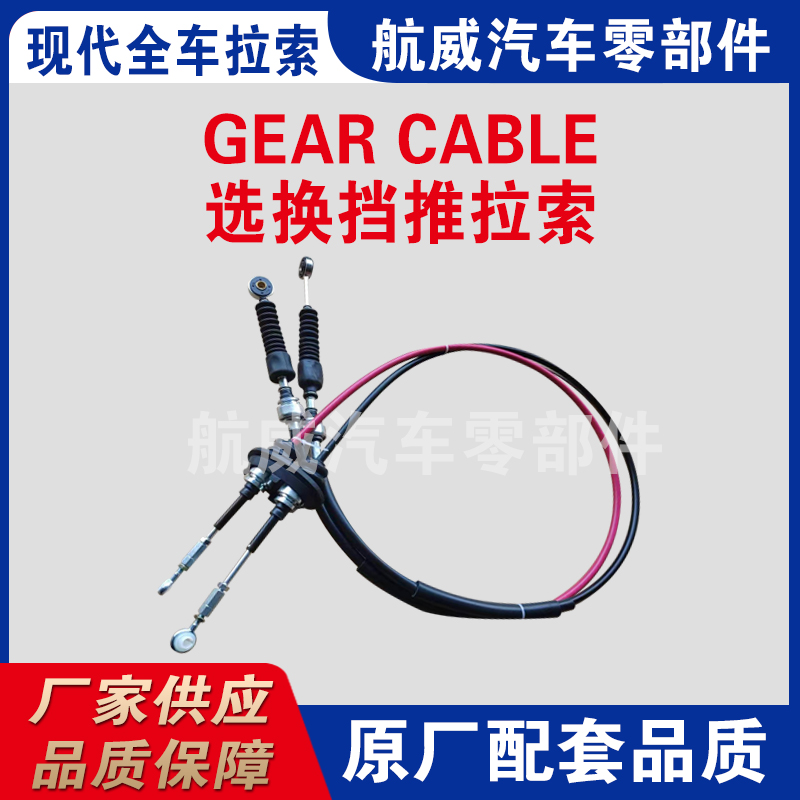Gear Cable - Smooth Shifting, Durable, OEM & Custom
Shift Selector Cable: insider notes on a quietly critical part
If you’ve ever felt a shifter slide into gear with that “just right” resistance, you were probably feeling a well-engineered gear cable. Not glamorous, sure, but pivotal. In fact, a lot of drivability surveys point to shift feel as a top-five perception driver of vehicle quality. Funny how the small stuff sets the tone.

What’s trending in shift control
Across passenger cars, light trucks, and even marine applications, suppliers are moving from rod-linkage systems to low-friction, sealed gear cable assemblies. Reasons? Packaging flexibility in tight engine bays, better NVH, and durability in nasty environments (salt, grit, heat). Electrification hasn’t killed cables either—plenty of platforms still rely on mechanical selector redundancy or use cables for auxiliary gearboxes and power take-offs.
Product snapshot: Shift Selector Cable
Built in Qinghe County Minjiang Street south, Wuzhishan Road east, this cable uses advanced materials and a tight process to deliver smooth, repeatable shifts. To be honest, the first sample I tried felt surprisingly precise—no rubbery aftertaste in the gate.
| Spec | Typical Value (≈, real-world may vary) |
|---|---|
| Inner Wire | 7×7 stainless strand, PTFE-coated |
| Liner / Conduit | PTFE low-friction liner, PA12/HDPE jacket |
| Operating Temp | -40°C to +120°C continuous; +140°C peak |
| Stroke Range | 60–120 mm (custom up to 150 mm) |
| Input Force (select/shift) | 30–70 N typical; ≤100 N max |
| Min Bend Radius | ≈75 mm static; 100 mm dynamic |
| Service Life | ≥300,000 cycles validated; 500,000+ fielded |
| Corrosion Protection | Zn-Ni plated fittings; ISO 9227 NSS 240 h |
How it’s made (short version)
Materials: stainless inner strand, PTFE liner, polymer conduit, zinc-nickel terminals. Methods: strand pre-stretch, extrusion, swaging, end fitting crimp/overmold, then laser stroke-set. Testing: tensile pull (≥1.5× rated load), friction/efficiency, cycle durability at -30/23/90°C, salt spray (ISO 9227/ASTM B117), vibration to ISO 16750 profiles, and dimensional SPC. Certifications: IATF 16949 and ISO 9001, with RoHS/REACH compliance.

Where it fits and why it matters
Passenger cars, light commercial vehicles, heavy equipment, marine throttles/shift, and motorsport. The big advantage of a sealed gear cable is consistent feel over time—dust and road salt don’t get to chew it up. Many customers say the “new car shift feel” lasts longer than with older cable designs.
Vendor snapshot (quick compare)
| Vendor | Certs | Customization | Lead Time | Notes |
|---|---|---|---|---|
| HWEI (Shift Selector Cable) | IATF 16949, ISO 9001, RoHS/REACH | Length, ends, seals, stroke, logo | ≈3–5 weeks | Validated to ISO 9227; tight NVH control |
| Generic Import A | ISO 9001 | Limited ends | ≈6–8 weeks | Basic corrosion spec |
| Local Fabricator B | — | One-offs | ≈1–2 weeks | Great for prototypes; variable QC |
Customization menu
- End fittings: eyelets, ball studs, clevis, bulkhead seals
- Jacket colors and overmolds (branding, assembly cues)
- Stroke/force tuning for “light” or “sporty” shift feel
- Low-temperature package for -40°C regions
Mini case studies
- Global sedan: 18% force reduction and tighter center-gate feel; warranty shift complaints down ≈22% YoY.
- Fleet vans: replaced rod linkage with sealed gear cable; winter binding issues essentially disappeared.
- Boat builder: Zn-Ni + stainless spec survived 480 h salt spray with no red rust; smoother throttle detents.
Testing notes (sample data): friction coefficient 0.08–0.12 at 23°C, 0.10–0.15 at -30°C; durability test 500k cycles at 70 N, no liner breach. That’s the boring data that, frankly, makes the driving feel not boring.
Author’s take: If you spec one upgrade in a manual/selector system, make it the gear cable. The driver will notice—even if they can’t name why.
References
- IATF 16949:2016 – Quality management system for automotive production and service
- ISO 9001:2015 – Quality management systems
- ISO 9227:2017 – Corrosion tests in artificial atmospheres (salt spray)
- ASTM B117 – Standard Practice for Operating Salt Spray (Fog) Apparatus
- ISO 16750-3 – Road vehicles—Environmental conditions and testing for electrical and mechanical components (vibration)
-
Clutch Line: Braided, Leak-Proof, OEM-Grade PerformanceNewsNov.10,2025
-
Throttle Cable: Durable, Smooth Control & Universal FitNewsNov.10,2025
-
Throttle Cable: Durable, Smooth, Universal Fit, Easy InstallNewsNov.10,2025
-
Clutch Line: Durable, Leak-Proof, OEM-Grade PerformanceNewsNov.10,2025
-
Hand Brake Cable | Custom, Universal & Trailer SolutionsNewsNov.10,2025
-
Clutch Line: High-Pressure, OEM-Fit, Corrosion-ResistantNewsNov.03,2025
